Here are the basic steps involved in using FormCalc SST. For simple calculations you may be able to follow these steps directly. If your needs are more complex, refer to the More Things to Know and Formulas Reference sections for additional details.
| If you have questions, or problems with these steps, please contact technical support at support@goflagship.com. |
1.QuickBooks: Open the form you want to work with
FormCalc SST works with all QuickBooks forms which (1) use Items and (2) have form customization as an option:
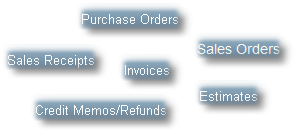
| In some cases you may want to customize the form to add fields or columns for holding additional data or calculated results. |
2.QuickBooks: Enter some data on the form
Fill out the form as you normally would, selecting a Customer or Vendor and entering at least three Item rows.
| Whatever data is on the form will be used as sample data in FormCalc SST. |
3.FormCalc SST: Take a snapshot of the form
Important!
Before taking the snapshot, be sure the QuickBooks form has the Customer Message (or Vendor Message) field in the footer area of the form. If it doesn't, customize the form so that this field appears in the form's footer area. FormCalc SST uses this field for navigating the form, so it is absolutely required.
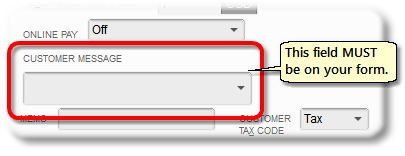
1.Start the FormCalc SST program.
2.Click the Action button in the main toolbar.

| This will cause the focus to switch to QuickBooks, where a Choose an action... pop-up window will be displayed over QuickBooks. |
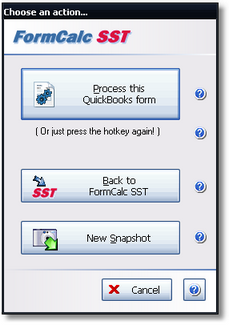
3.Click the New Snapshot button in this window, then avoid typing or moving the mouse while FormCalc SST works.
| FormCalc SST will visit each of the form's fields, gathering data about the form, and building a spreadsheet representation of it on the Snapshot tab in FormCalc SST. |
| Finally, the focus will switch back to the Snapshot tab in FormCalc SST, where the snapshot data will be visible. |
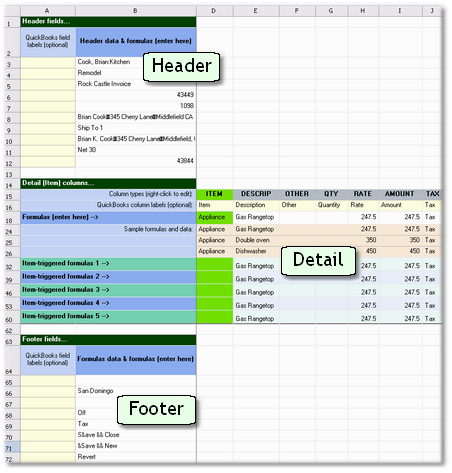
4.FormCalc SST: Assign column types
Right-click cells on the Column types row in the Detail section, and choose a column type appropriate for each column. You must at least choose a type for the Item column and for any column where you will enter formulas.
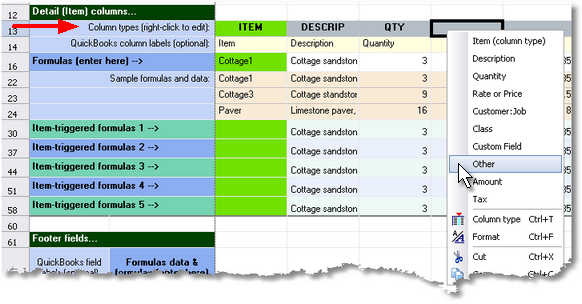
| You may also want to enter field labels for some or all fields, to match the field names in QuickBooks. Doing that can reduce confusion as you work with fields and enter formulas. |
5.FormCalc SST: Enter spreadsheet formulas
Formulas you enter in FormCalc SST will be used to calculate results when processing your QuickBooks forms later. You can enter formulas in the cells shown here:
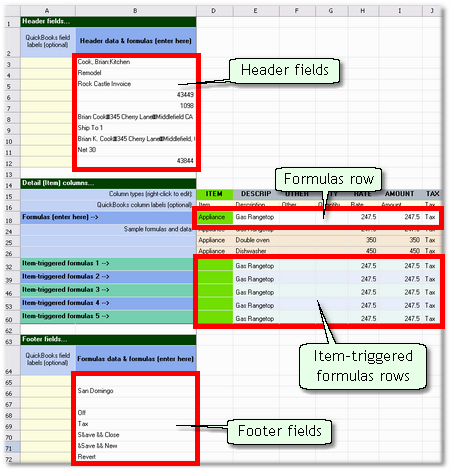
Here's an example formula:
| =SUM(E19,B7:B9) |
Things to know:
= |
All formulas begin with an equal sign. This is what distinguishes formula cells from cells containing text and data. |
SUM() |
Formulas often include one or more built-in function such as SUM(), which sums whatever is between its parentheses. For a full list of operators and functions, see the Formulas reference section. |
E19 |
This is a reference to a single cell, E19. |
B7:B9 |
This is a reference to a range of cells, from B7 through B9. A range reference consists of two cell references separated by a colon (:) |
Which cells can formulas refer to?
Header formulas |
Can refer to other Header cells and to Footer cells. |
Formulas row formulas |
Can refer to Header cells, Footer cells, other cells on the Formulas row, and cells on the Formulas row's anchor row. |
Item-triggered formulas |
Can refer to Header cells, Footer cells, other cells on the same Item-triggered formula row (i.e., not to cells on other Item-triggered rows), and to cells on the Item-triggered row's anchor rows. (Item-triggered rows have several anchor rows, to support the mini-spreadsheet feature.) |
Footer formulas |
Can refer to other Footer cells and to Header cells. |
| See the Formulas and cell references section for more details about formulas. |
6.FormCalc SST: Format the results
If the format of calculated results in a formula cell doesn't match what you want to see in QuickBooks, right-click it and choose Format from the pop-up menu.
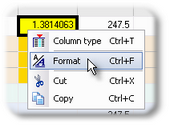
This will open the Format data or results window, where you can choose the formatting options you want.
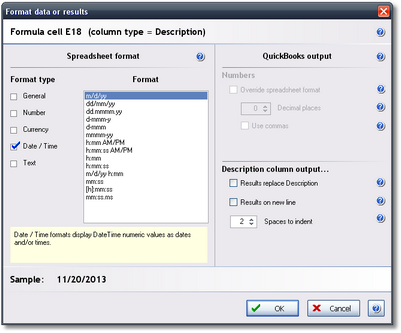
| See the Formatting data and calculated results topic for more details. |
7.FormCalc SST: Save the file often!
Don't forget to save your FormCalc SST file as you're working on it, so you don't lose any of your formulas or other changes. You can use the Save button in the main toolbar:

8.QuickBooks: Test your FormCalc SST setup
1.In QuickBooks, open or click on the form you want to process, if you are not already working in that form.
2.Press the FormCalc SST hotkey—the F11 key unless you have changed it in Preferences.
| The Choose an action... window will pop up over QuickBooks. |

3.Click the Process this QuickBooks form button...or press the hotkey a second time.
| Pressing the hotkey a second time is quicker for most users. |
| FormCalc SST will visit the form's fields, gathering data for calculations and inserting calculated results in the fields and columns corresponding to the cells where you entered formulas. |
| If the results were not what you intend, change or adjust formulas and formatting in FormCalc SST, then try processing the form again. |
| The Revert button found on most QuickBooks forms is handy for returning the form to its original state, prior to FormCalc SST's calculations. |
| If you change the layout of your QuickBooks form—change column or field order, or add or remove columns or fields—then you'll have to take a new snapshot. (You can retrieve formulas from the prior snapshot by Copying them from the OLD Snapshot tab and Pasting them into the appropriate cells in the Snapshot tab. |
9.Use your FormCalc SST setup for data entry!
Once you have a FormCalc SST file set up for a particular QuickBooks form, the work is done. All that's left to do is use it!
Using FormCalc SST to process forms adds just one step to your data entry cycle. Instead of: enter data on a form, save the form...and repeat, your data entry cycle will be: enter data on a form, invoke FormCalc SST to do calculations, save the form...and repeat.
Most users have only one FormCalc SST file, for working with a single QuickBooks form such as an Invoice. FormCalc SST loads the most recently used file when it starts up, so having the correct file loaded is automatic in most cases.
However, you may have several files, for working with different forms...or for working with several different customers' forms if you provide bookkeeping services to others. In those cases, be sure you have the correct FormCalc SST file loaded before processing forms.